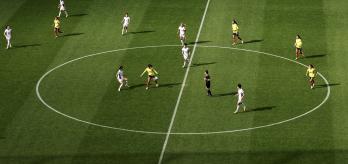Team dashboards
HOW ENGLAND ATTACK – PROGRESSING THEIR PLAY
England like to build their play from the back and play through their opposition's lines. In this tournament their build-up phases have often been unopposed; this is illustrated by the Lionesses having the second-highest number of ball receptions under no pressure, with 383 receptions per 30 minutes in possession (because the ball is in play for approximately 60 minutes, the data is normalised per 30 minutes). England are also the number one ranked team for proportion of in-possession time spent in mid build-up (28.3%). When their three centre-backs are building play, the movements of their three midfielders ahead of the ball are vital as they create passing lanes that facilitate line-breaks through the opposition's shape.
Sarina Wiegman's side are ranked second in the tournament for pass completion rate (86.1%) and for line-break completion rate (73.1%). Only Spain, their opponents in Sunday's final, are ranked ahead of them. However, the most efficient route to the opposition's goal is by going directly through the opponent's shape, and in this metric England are ranked first with 85% of their line breaks through the opposition being completed.
According to Belinda Wilson, and as we see in Clips 1 and 2 below, "The movement of England's players between the lines of the opposition's defensive and midfield units is paramount in how they achieve this. Their centre-forwards and attacking midfielders drop into this space, creating overloads and opening passing lanes. Their wing-backs provide width which helps them stretch the defences they are playing against and open more space.
"Technically England's players are excellent, as they move the ball with minimal touches and follow passes with forward runs to overload against the next line of the opposition's defence. When they do get into the final third, they get numbers into and around the penalty area to support their attacks."
Accuracy and efficiency in attack
When they get into the final third, England have real variety in the way they can complete attacks. They have players that can go 1v1, shoot from distance and finish from crosses. The first-time finalists are also quite selective about their attempts at goal; despite being ranked 25th out of the 32 participants for attempts at goal (12.3 per 90 minutes), England steer 42.7% of these attempts on target. The Lionesses rank third for goal conversions, with 15.9% of their attempts at goal resulting in a goal being scored.
HOW ENGLAND DEFEND – SETTING TRAPS TO APPLY DIRECT PRESSURE
England adopt a ball-orientated block when out of possession, meaning they get into shape in anticipation of a pressing trigger. As soon as the ball is passed to an opposition player who is in direct-pressure range, the Lionesses initiate intense, consecutive sequences of direct pressure.
England have the fitness levels to sustain these pressing sequences and are ranked fourth for the average duration of a press. However, they are selective about when they press and when they do commit, they press with intensity. When we explore their pressing data, England rank 27th out of the 32 participants for indirect pressure (136.9 per 30mins) but fourth for direct pressure (68.5 per 30mins).
When close enough to contest the ball, England achieve good success. At this stage of the tournament, they rank second for duels won (9.8 per 30mins out of possession).
According to Wilson, "England set traps for the teams they are playing against and collaborate closely to execute their defensive plan. They press in a co-ordinated way, often starting in wide areas and once they start it, they maintain this pressure, limiting their opponent's ability to progress the ball."
KEY PLAYER – Millie Bright
England captain Millie Bright (6) has been a tower of strength for her team defensively during this tournament. The Chelsea centre-back has been a vital cog in the Lionesses' defensive unit through her intuitive reading of important game situations and her ability to make timely interventions.
As can be seen in Clip 5, 6 and 7, Bright does not only contribute to her team in the defensive sense. She has the vision and technique to execute inch-perfect long passes over the opponent's defensive line and the courage to step in with the ball to create overloads.
She is a strong communicator on the pitch and a great leader within her team.
GOALKEEPER SPOTLIGHT – Mary Earps
England goalkeeper Mary Earps (1) has had an impressive tournament. Her athleticism, timing and decision-making have helped her make important interventions for her team; the Manchester United Number 1 is dominant in 1v1 situations and makes big saves during match-defining moments. In addition, Earps has a strong ability to deal with high balls and great power and range when dealing with attempts at goal from outside the penalty area.
In the clip sequences below, Pascal Zuberbühler explains some of her key goalkeeping attributes that have stood out in her performances so far.
Attempts from distance
"In Clip 8 against China, what is important is that she stays on her feet. The longer she stays on her feet the better her judgement can be for the timing and height of the dive as the ball bounces in front of her. Her decision-making is good and she can make the deflection away from danger.
"In Clip 9 we see another dipping ball so again, it is important to stay on your feet as long as possible to get the timing right. At the time of the attempt at goal she is already in the set position, but her line of vision is blocked by her two defenders. Her reaction is fast, and she dives to her left in a powerful way to push the ball away with two hands."
High Balls
"In Clip 10 the first thing to say is about her open body position and how gets ready for the cross as soon as she recognises the player is unopposed. She is already on her toes as the ball is played and this allows her to make the important first steps backwards. Her timing also must be perfect here to get the touch to deflect the ball away. This is not simple, and she executed it perfectly."
"In the eleventh clip, we see a similar example where she is open, and she knows where she is in relation to her own goal. This type of ball is difficult because the timing and height of the jump must be perfect. Again, she gets good elevation and makes the intervention."
Key Saves
"As we see in Clip 12, Earps makes a very important save at a crucial time in the semi-final against Australia. In the 83rd minute and with the score at 2-1 in England's favour, she prevents the equaliser. Her starting position at her front post and the way she is poised on the front of her feet in the set position means she is ready to push and stretch to reach the ball with a very strong right hand. Also, the way her defenders react to the rebound shows a great connection between them and their goalkeeper."
"In Clip 13, against Haiti, England were 1-0 up in the final minutes of the game when she made another crucial save. Again, I want to talk about her positioning and those important first steps that she takes to help her make the goal smaller for the striker. From this position she can make the save with her left foot. It's a strong, powerful save and shows her positive mentality and athleticism," he added.
The FIFA Women's World Cup 2023™ final between Spain and England takes place on Sunday, 20th August at Stadium Australia in Sydney with a 20:00 kick-off (local time).

















